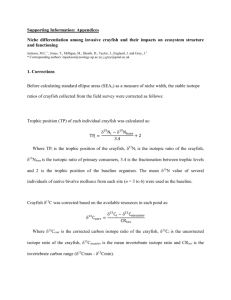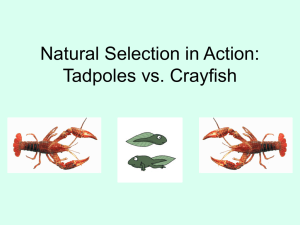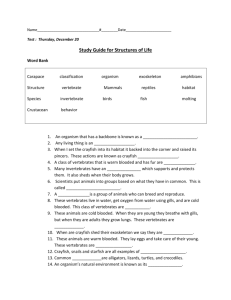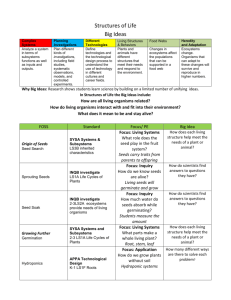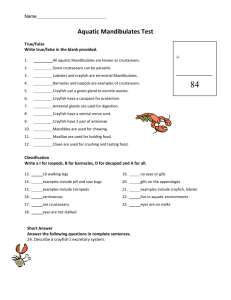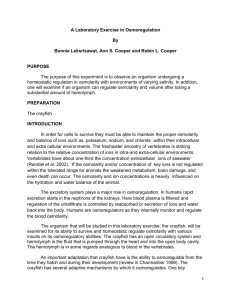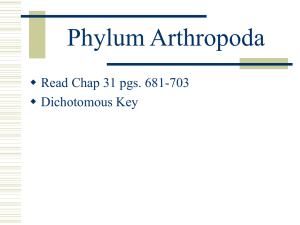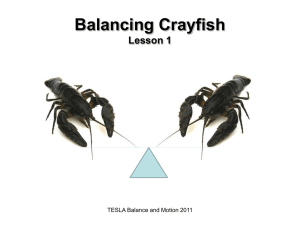MS word
advertisement
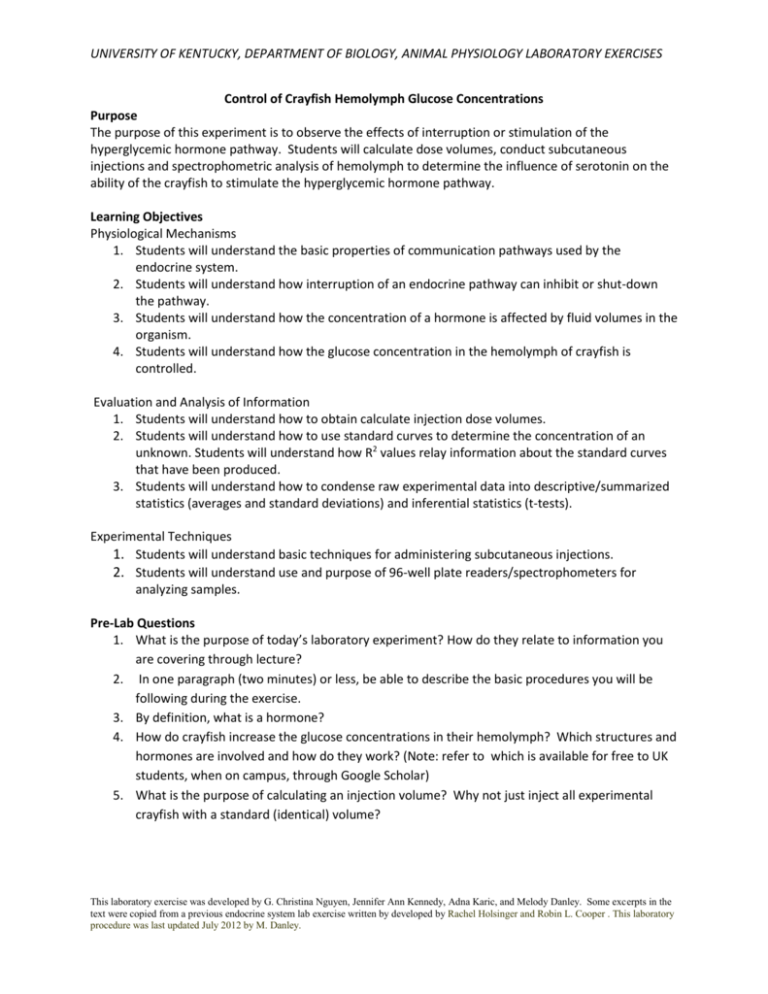
UNIVERSITY OF KENTUCKY, DEPARTMENT OF BIOLOGY, ANIMAL PHYSIOLOGY LABORATORY EXERCISES Control of Crayfish Hemolymph Glucose Concentrations Purpose The purpose of this experiment is to observe the effects of interruption or stimulation of the hyperglycemic hormone pathway. Students will calculate dose volumes, conduct subcutaneous injections and spectrophometric analysis of hemolymph to determine the influence of serotonin on the ability of the crayfish to stimulate the hyperglycemic hormone pathway. Learning Objectives Physiological Mechanisms 1. Students will understand the basic properties of communication pathways used by the endocrine system. 2. Students will understand how interruption of an endocrine pathway can inhibit or shut-down the pathway. 3. Students will understand how the concentration of a hormone is affected by fluid volumes in the organism. 4. Students will understand how the glucose concentration in the hemolymph of crayfish is controlled. Evaluation and Analysis of Information 1. Students will understand how to obtain calculate injection dose volumes. 2. Students will understand how to use standard curves to determine the concentration of an unknown. Students will understand how R2 values relay information about the standard curves that have been produced. 3. Students will understand how to condense raw experimental data into descriptive/summarized statistics (averages and standard deviations) and inferential statistics (t-tests). Experimental Techniques 1. Students will understand basic techniques for administering subcutaneous injections. 2. Students will understand use and purpose of 96-well plate readers/spectrophometers for analyzing samples. Pre-Lab Questions 1. What is the purpose of today’s laboratory experiment? How do they relate to information you are covering through lecture? 2. In one paragraph (two minutes) or less, be able to describe the basic procedures you will be following during the exercise. 3. By definition, what is a hormone? 4. How do crayfish increase the glucose concentrations in their hemolymph? Which structures and hormones are involved and how do they work? (Note: refer to which is available for free to UK students, when on campus, through Google Scholar) 5. What is the purpose of calculating an injection volume? Why not just inject all experimental crayfish with a standard (identical) volume? This laboratory exercise was developed by G. Christina Nguyen, Jennifer Ann Kennedy, Adna Karic, and Melody Danley. Some excerpts in the text were copied from a previous endocrine system lab exercise written by developed by Rachel Holsinger and Robin L. Cooper . This laboratory procedure was last updated July 2012 by M. Danley. UNIVERSITY OF KENTUCKY, DEPARTMENT OF BIOLOGY, ANIMAL PHYSIOLOGY LABORATORY EXERCISES 1. Introduction A hormone is a chemical message that is released by one cell and transported to a distant target cell where it delivers a message (i.e. exerts a response). In triploblastic (develop from 3 germ layers) animals, hormones are produced and secreted by endocrine tissue. Endocrine tissue develops from the mesoderm (meso- is a word root for middle) tissue layer of a developing embryo. In contract, nervous tissue develops from the ectoderm (ecto- is a word root for outside) tissue layer. So there is a distinct difference between true endocrine tissue and nervous tissue. Hormones are chemical messages produced and released by endocrine tissue. In contrast, neurhormones, neurotransmitters, and neuromodulators are chemical messages produced and released by nervous tissue. However, the word “hormone” is often used to indicate either source of chemical message so long as the chemical is transported longdistance through the circulatory system of the animal. In animals like mammals, which have closed circulatory systems, hormones are transported in the blood to stimulate specific target cells. In contrast, insects and crustaceans have an open circulatory system so called because the hemolymph is contained in a cavity called a hemocoel along with open-ended vessels. Hemolymph, a fluid equivalent to blood, directly bathes tissue such as muscles and parts of the nervous system and contains blood cells, lymph, and interstitial fluid. Despite having an open circulatory system, insects still use hormones to relay messages amongst cells. Hormones travel to target tissues in the hemolymph just as they would in the blood of a mammal. Homeostasis is maintained in many ways by hormones. The nervous system and endocrine system are closely linked; hormones influence development of neurons and conversely the nervous system affects hormone production and secretion. For example, during stressful situations, nerves signal for an increase in secretion of certain hormones (i.e. epinephrine, glucagon) and a decrease in the secretion of others (i.e. insulin). The nervous system and endocrine systems work in compliment to one another. When needed, the nervous system is able to exert its effect rapidly, via electrical signals. Endocrine signaling via hormones usually takes a slower but often longer-lasting route. For example, blood glucose is regulated by both the nervous system and endocrine systems. This laboratory exercise was developed by G. Christina Nguyen, Jennifer Ann Kennedy, Adna Karic, and Melody Danley. Some excerpts in the text were copied from a previous endocrine system lab exercise written by developed by Rachel Holsinger and Robin L. Cooper . This laboratory procedure was last updated July 2012 by M. Danley. UNIVERSITY OF KENTUCKY, DEPARTMENT OF BIOLOGY, ANIMAL PHYSIOLOGY LABORATORY EXERCISES Under normal conditions, glucagon and insulin maintain homeostasis of human blood glucose concentrations at around 80 mg/dL. If an individual eats a sugar laden meal, then as the sugar is absorbed from the digestive tract into the blood, the blood glucose concentrations will increase. The body responds by releasing more insulin, which stimulates the liver and skeletal muscle to remove the excess sugar from the blood and put the sugar into storage. If the blood glucose concentrations decrease, the body can respond by decreasing the amount of insulin released, and increasing the amount of glucagon released. Glucagon signals to the liver and skeletal muscle to break-down glycogen (the storage form of glucose) and release it into the blood. Under stressful conditions, the nervous system can stimulate release of epinephrine into the blood, which in turn stimulates the rapid breakdown and release of glucose into the blood. Increasing or decreasing blood glucose concentrations via the endocrine pathway commonly takes 1-2 hours, whereas stimulation via the nervous system can take as little as 30 seconds. 1.2 Control of Hemolymph Glucose in Crustaceans While many crustaceans regulate glucose concentrations in their hemolymph like humans, they do not use the same hormones as those of higher order mammals, nor do they maintain their glucose concentrations at the same levels. For example, Procambarus clarkii (common freshwater crayfish) maintain their hemolymph glucose concentrations at approximately 15 mg/dL (Lee et al. 2000) compared to the 80 mg/dL of humans. And, crustaceans do not produce glucagon or insulin. To complicate this further, many crustaceans do not use glucose as a primary source of metabolic energy, but instead use other types of sugars or fats. So the pathway for control of glucose concentrations in crustaceans has received only limited attention to date. To date, it is known that crayfish and related decapod crustaceans produce crustacean hyperglycemic hormone, or CHH, in the sinus glands (SG) located at the base of the eyestalk. Release of CHH from the sinus glands causes a gradual increase in the hemolymph glucose concentration, reaching a maximal effect after about an hour. In humans, an increase in glucagon in the liver causes a similar result. It is not known if crustaceans produce a hormone to reduce hemolymph glucose concentrations (like insulin does in the blood of humans). This laboratory exercise was developed by G. Christina Nguyen, Jennifer Ann Kennedy, Adna Karic, and Melody Danley. Some excerpts in the text were copied from a previous endocrine system lab exercise written by developed by Rachel Holsinger and Robin L. Cooper . This laboratory procedure was last updated July 2012 by M. Danley. UNIVERSITY OF KENTUCKY, DEPARTMENT OF BIOLOGY, ANIMAL PHYSIOLOGY LABORATORY EXERCISES When studying endocrine pathways, there are many techniques that can be used to determine where and how endocrine pathways work. For example, recent research has shown that release of CHH can be stimulated by the neuromodulator serotonin (5-Hydroxytryptamine or 5-HT) in a dose-dependent manner (Lee et al. 2000; Zou et al. 2003). Injections of 10-7 mol 5HT causes a significant increase of hemolymph glucose concentrations (average 30-50 mg/dL 1 hour after injection). If CHH is required to increase the glucose concentration in crayfish, then removal of the sinus gland (and thus the source of CHH producing/releasing cells) should disrupt the endocrine pathway. Therefore, crayfish that have had their sinus glands removed (and have no source of CHH) should be unable to increase their hemolymph glucose concentrations following injection with serotonin, if the sinus gland is the true source of the CHH. Left image: Sketch of the glandular tissue in the eyestalk of crayfish Procambarus clarkia (from Cebada and Garcia 2007). Right image: Close-up of the crayfish eyestalk. 1.3 Specific Experiments and Questions for Today’s Laboratory Exercise You will be completing one experiment with two different treatments for today’s laboratory exercise. The first treatment will serve as the control. Control treatment crayfish will be those with their eyestalks intact and thus have their sinus gland and CHH-producing cells present. The second treatment will be those with their eyestalks removed (and are assumed to have no CHH-producing cells). Both treatment groups will be injected with a size-dependent dose of serotonin and the resulting hemolymph glucose concentrations compared. Towards the end of the lab period, your lab instructor will help you analyze the results using SPSS and Excel software. Experiment 1: Does removal of the sinus gland disrupt the ability of serotonin to stimulate an increase in glucose concentrations in the hemolymph of crayfish? This laboratory exercise was developed by G. Christina Nguyen, Jennifer Ann Kennedy, Adna Karic, and Melody Danley. Some excerpts in the text were copied from a previous endocrine system lab exercise written by developed by Rachel Holsinger and Robin L. Cooper . This laboratory procedure was last updated July 2012 by M. Danley. UNIVERSITY OF KENTUCKY, DEPARTMENT OF BIOLOGY, ANIMAL PHYSIOLOGY LABORATORY EXERCISES 2. Procedure 2.1 Crayfish Weight and Injection Volume 1. Select one crayfish from the group with their eyestalks removed. 2. Obtain a second crayfish from the control tank of crayfish. 3. Carefully blot dry each crayfish with paper towel and weigh the experimental crayfish. Be sure the digital balance is zeroed (tared) prior to weighing. Record the weights below. a. Weight of eyestalk removed crayfish (g): _______________ b. Weight of control crayfish (g): _______________ 4. Use the equation below to calculate the amount of 5-HT needed to obtain a 200nM 5-HT hemolymph concentration. Approximately 30% of the weight for a blue crab or a lobster is hemolymph (Gleeson and Zubkoff, 1977; Guirguis and Wilkens, 1995); assume this percentage also holds true for crayfish in these experiments. The 5-HT stock solution is 4 µM. Determine the amount of stock solution (V2) to be injected into the crayfish for a circulating concentration of 200 nM 5-Ht using the following calculations: crayfish weight x .30 = hemolymph volume M1V1 = M2V2 (0.200 µM) (hemolymph volume) = (4 µM) (V2) 5. Record the injection volume (V2) in ml, below. For example, based on these concentrations, a 10 gram crayfish should be injected with a 0.15 ml of serotonin solution for to obtain a hemolymph dose of 200 nM. (the space below has been left open for calculations) DATA! Eyestalk removed crayfish injection volume (ml): ______________ DATA! Control crayfish injection volume (ml): ______________ 6. Double check the calculation with the teaching assistant/ instructor and obtain a syringe and needle containing the stock 5-HT. The serotonin has been prepared in a crayfish saline solution. The control saline is composed of crayfish saline (mM: 205 NaCl; 5.3 KCl; 13.5 CaCl2.2H2O; 2.45 MgCl2.6H2O; 5 HEPES adjusted to pH 7.4) which is a modified Van Harreveld (1936) saline. The saline will also have a microfilter attached to keep out bacteria. 7. To inject the crayfish, first wrap the head and thorax of the crayfish in moistened paper towels. Leave only the abdomen exposed. Position your hand to hold the tail spread out with your This laboratory exercise was developed by G. Christina Nguyen, Jennifer Ann Kennedy, Adna Karic, and Melody Danley. Some excerpts in the text were copied from a previous endocrine system lab exercise written by developed by Rachel Holsinger and Robin L. Cooper . This laboratory procedure was last updated July 2012 by M. Danley. UNIVERSITY OF KENTUCKY, DEPARTMENT OF BIOLOGY, ANIMAL PHYSIOLOGY LABORATORY EXERCISES pinky finger or have your partner hold the tail down (Figure 1). Figure 1. Image shows the crayfish head and thorax wrapped in moistened paper towels. Wrapping the crayfish helps calm it and minimize injury to the individual holding the animal. Notice the ventral side of the abdomen remains exposed since it is the site for the injection. TAKE CAUTION as a crayfish bite, pinch, or tail flip can cause injury. It is not the strength of the muscle pinching that hurts but the fine teeth like structure at the tip that can pierce the skin. If your skin is broken by a bite, pinch or tail flip wash well with soap and water and inform the teaching assistant/ instructor. 8. Inject the experimental crayfish with the appropriate volume of 5-HT by inserting the needle in the clear space toward the edge of the abdomen, just below the membrane. Gloves and safety glasses should be worn when injecting the crayfish since serotonin is potent neurotransmitters in crayfish and humans. Do not inject into the midline of the abdomen because this is the location of the central nerve cord (Figure 2). Figure 2. Image shows the crayfish wrapped in paper towels held by one group member. The other group member is injecting the serotonin just below the articulating membrane of the abdomen. After injecting the correct volume, the needle should be held for an additional 20 to 30 seconds before being withdrawn. This allows the injected volume to mix with the hemolymph, and minimizes the potential for it to come back out of the injection site. This laboratory exercise was developed by G. Christina Nguyen, Jennifer Ann Kennedy, Adna Karic, and Melody Danley. Some excerpts in the text were copied from a previous endocrine system lab exercise written by developed by Rachel Holsinger and Robin L. Cooper . This laboratory procedure was last updated July 2012 by M. Danley. UNIVERSITY OF KENTUCKY, DEPARTMENT OF BIOLOGY, ANIMAL PHYSIOLOGY LABORATORY EXERCISES 9. After injecting the serotonin, hold the needle in place for approximately 30 seconds to minimize the potential for the solution to leak out when withdrawing the needle. Record the injection time: DATA! Eyestalk removed crayfish injection time: _______________ DATA! Eyestalk removed crayfish hemolymph sampling time: _________________ (1 hour after injection) 10. Repeat the procedure second crayfish. DATA! Crayfish 2 injection time: ______________ DATA! Hemolymph sampling time: ________________ (1 hour after injection) 11. Place the crayfish in the observation tanks; one crayfish per tank (Figure 3). Crayfish are very visual so minimize the visual disturbance around the crayfish. Allow the serotonin to take effect for 1 hour. Figure 3. Image shows the observation tanks with crayfish. Crayfish should be placed in the observation tanks for 1 hour after injection of serotonin, to allow the serotonin to take effect. 2.2 Hemolymph Collection 1. Please note: Hemolymph is very prone to clotting! Keep the sample cold whenever possible. Never set the leave the hemolymph exposed to room temperature for prolonged period of times. Once clotted, the hemolymph sample can no longer be analyzed. 2. After the 1 hour waiting period, remove the crayfish from their observation tanks. Place the crayfish in an ice-water bath for 10 to 15 min to anesthetize them. 3. While the crayfish is being anesthetized, prepare the materials for hemolymph collection. First, obtain a syringe prefilled with chilled, 0.1 ml of EDTA solution, and two 1.5 mL microcentrifuge tubes labeled with a permanent marker. 4. Check the syringe to ensure no air bubbles are present with the EDTA solution. If bubbles are visible, flush the EDTA solution from the syringe and refill with 0.1 mL of the chilled EDTA solution. IMPORTANT NOTE: When air is present in the syringe, it can prevent proper mixing of This laboratory exercise was developed by G. Christina Nguyen, Jennifer Ann Kennedy, Adna Karic, and Melody Danley. Some excerpts in the text were copied from a previous endocrine system lab exercise written by developed by Rachel Holsinger and Robin L. Cooper . This laboratory procedure was last updated July 2012 by M. Danley. UNIVERSITY OF KENTUCKY, DEPARTMENT OF BIOLOGY, ANIMAL PHYSIOLOGY LABORATORY EXERCISES the EDTA anticoagulant with the hemolymph as the hemolymph is collected, thereby making it more likely the hemolymph will clot. Keep the syringe chilled (in a small beaker, placed on ice) until ready to collect hemolymph. 5. When the crayfish is properly anesthetized (can be handled without tail flipping or making erratic movements), have one group member hold the crayfish while the other group member collects the hemolymph using the EDTA filled syringe. Hold the crayfish firmly on the thorax with one hand, gently tucking its tail under with the other hand, flexing the joint between the abdomen and thorax region (Figure 4). The heart is located on the dorsal side, just anterior to the joint separating the thorax and abdomen. Figure 4. Left image: Location of the crayfish heart for collection of hemolymph. Right image: Shallow insertion of the needle through the joint separating the thorax from the abdomen, at a 45’ angle into the heart, will allow for easy collection of hemolymph from the crayfish. 6. Observe the grey tissue that is visible along the dorsal (back) side, along the midline, through the opening of the flexed joint (Figure 4). The grey tissue visible through the joint is the crayfish heart. Gently insert the needle into the heart, going no deeper than 1 centimeter (or 0.25 inches). Inserting the needle deeper into the crayfish runs the risk of going through the heart, and puncturing the stomach below, thus collecting stomach contents rather than hemolymph. 7. Withdraw approximately 0.5 ml of hemolymph from the heart of the crayfish (0.5 mL hemolymph + 0.1 ml EDTA = total volume of 0.6 ml in the syringe). Record the actual sample volume that is collected in the space below: DATA! Eyestalk removed crayfish hemolymph volume collected (ml): ______________ DATA! Control crayfish hemolymph volume collected (ml): ______________ 8. Gently invert each syringe several times to ensure proper mixing of the EDTA solution with the hemolymph. Do not shake the sample since this may introduce air bubbles into the sample and increase the likelihood of clotting! 9. Slowly eject the hemolymph/EDTA solution into the microcentrifuge tube and cap. Dispose of the syringe in the red “Biosharps” container along the side counter. Note: It is not necessary to This laboratory exercise was developed by G. Christina Nguyen, Jennifer Ann Kennedy, Adna Karic, and Melody Danley. Some excerpts in the text were copied from a previous endocrine system lab exercise written by developed by Rachel Holsinger and Robin L. Cooper . This laboratory procedure was last updated July 2012 by M. Danley. UNIVERSITY OF KENTUCKY, DEPARTMENT OF BIOLOGY, ANIMAL PHYSIOLOGY LABORATORY EXERCISES remove the needle from the syringe. The used syringe with needle should be disposed of in the biosharps container. 10. Immediately invert the hemolymph sample several times to thoroughly mix the EDTA and hemolymph, then centrifuge the sample for 3 minutes using a small benchtop centrifuge using the following guidelines: a. Be sure to counterbalance the weight of the sample in the centrifuge. b. If the centrifuge is not immediately available, place the sample on ice until it can be centrifuged. Keeping the sample cold helps minimize clotting. c. Do not centrifuge the sample for more than 3 min, since the motion of the centrifuge tends to warm the sample, making it more prone to clotting. 11. After centrifuging the sample, pipette the upper 50% of the supernatant (liquid portion on top) into a new centrifuge tube and cap the sample. Do not transfer the debris that has gathered at the bottom of the original tube. Keep the supernatant sample on ice until you are ready to analyze it for glucose. Throw the original centrifuge tube with the debris at the bottom into the trash can. This laboratory exercise was developed by G. Christina Nguyen, Jennifer Ann Kennedy, Adna Karic, and Melody Danley. Some excerpts in the text were copied from a previous endocrine system lab exercise written by developed by Rachel Holsinger and Robin L. Cooper . This laboratory procedure was last updated July 2012 by M. Danley. UNIVERSITY OF KENTUCKY, DEPARTMENT OF BIOLOGY, ANIMAL PHYSIOLOGY LABORATORY EXERCISES 2.3 Hemolymph Analysis 1. Obtain a 96-well plate being careful not to touch the bottom surface of the plate. 2. Use the table below to identify where your samples will be placed into the 96-well plate. You will need 6 wells for standards, and for 4 wells for each of the hemolymph samples you will be analyzing, as follows: a. 2 wells with 0 mg/dl glucose standard + reagent b. 2 wells with 50 mg/dl glucose standard + reagent c. 2 wells with 100 mg/dl glucose standard + reagent d. 4 wells with hemolymph from the eyestalk removed crayfish (two for determination of glucose, and two to account for background absorbance due to coloration of the hemolymph) e. 4 wells with hemolymph from the control crayfish (two for determination of glucose, and two to account for background absorbance due to coloration of the hemolymph) DATA! Plate Location Rep 1 Rep 2 Add all of these first.. Sample (50 L per well) Then add… Glucose Reagent (200 L per well) Eyestalk removed crayfish hemolymph Eyestalk removed crayfish hemolymph 200 L reagent Control crayfish hemolymph Control crayfish hemolymph 200 L reagent Distilled water 200 l reagent 50 mg/dl standard 200 l reagent 100 mg/dl standard l reagent None – for this set of wells, use 200 L distilled water in place of the glucose reagent. This set is necessary to control for absorbance due to the color of the hemolymph None – for this set of wells, use 200 l distilled water in place of the glucose reagent. This set is necessary to control for absorbance due to the color of the hemolymph 3. Once the locations have been determined, pipette 50 microliters of the correct hemolymph (or standard) sample into its appropriate well. Change the pipette tip between each sample. Used tips should be discharged into the trash can. Repeat until all appropriate wells have been loaded with samples. This laboratory exercise was developed by G. Christina Nguyen, Jennifer Ann Kennedy, Adna Karic, and Melody Danley. Some excerpts in the text were copied from a previous endocrine system lab exercise written by developed by Rachel Holsinger and Robin L. Cooper . This laboratory procedure was last updated July 2012 by M. Danley. UNIVERSITY OF KENTUCKY, DEPARTMENT OF BIOLOGY, ANIMAL PHYSIOLOGY LABORATORY EXERCISES 4. Once all the samples have been pipetted into the wells, add the glucose reagent (or distilled water) to the wells. When all the wells are prepared (sample + reagent), place a seal over the top surface of the plate and gently vortex/shake the plate from side to side to ensure mixing of the sample with the reagent. Slowly remove the seal (being careful not to mix solutions amongst the different wells), and allow the samples to incubate for 15 minutes. 5. Place the plate onto the holder of the 96-well plate reader (spectrophotometer). Set the reader to a wavelength of 340 nm and allow the samples to be read. Record the resulting absorbance for each sample in the table below. DATA! Table 2. Results of spectrophometric analysis of the samples by the 96-well plate reader. Rep 1 Plate location Absorbance Rep 2 Plate location Absorbance Average Absorbance 2.4 Glucose Calculations 2.4.1 Determining the Linear Equation from a Standard Curve Your first calculation will be to calculate the relationship between hemolymph glucose concentrations and absorption. In general, as the glucose concentration increases, the absorbance of light by the sample should also increase in a predictable, linear manner. The related data can be used to calculate the relationship between absorbance and glucose concentrations, in the form of the linear equation: y = mx + b Where: y = absorbance m = slope of the line x = concentration of glucose in the sample b = intercept of the line across the y-axis Begin by entering your “standards” absorbance data into an Excel spreadsheet using the following format. Use only the data from your plate readings (those from other groups or plate will vary). The first This laboratory exercise was developed by G. Christina Nguyen, Jennifer Ann Kennedy, Adna Karic, and Melody Danley. Some excerpts in the text were copied from a previous endocrine system lab exercise written by developed by Rachel Holsinger and Robin L. Cooper . This laboratory procedure was last updated July 2012 by M. Danley. UNIVERSITY OF KENTUCKY, DEPARTMENT OF BIOLOGY, ANIMAL PHYSIOLOGY LABORATORY EXERCISES column should contain the standard concentrations, and the second column should contain the corresponding absorbance readings. Standard Glucose Conc. Absorbance (mg/dl) (nm) 100 100 50 50 0 0 Once this information has been entered into the Excel spreadsheet, Select the “data” tab at the top of the screen, then Select “data analysis”, which is usually located at the far right side of the data tab options. Note, if this option is not visible (or disappears), you may need to close the program and reopen it. From the data analysis window that pops up, select “regression” from the list, then select “OK” From the regression window that pops up, use the mouse to select the Y data (absorbance) and X data (glucose concentrations) from your spreadsheet. Select “OK” From the output that appears, locate the Intercept x Coefficient cell. This number represents the “b” or Y intercept of the linear equation. Record this information below. DATA! b = ____________ From the output that appears, locate the X Variable x Coefficient cell. This number represents the “m” or slope of the linear equation. Record this information below. DATA! m = ____________ Finally, record the R2 value ( or linear correlation coefficient) from the output. The R2 is a reflection of how well the linear equation is able to predict the glucose concentrations from the absorbance data. The closer the value is to 1.0, the better the prediction. In the research laboratory setting, a minimum R2 of .95 is often required. However, for the purpose of the teaching laboratory setting, a correlation coefficient as low as 0.80 is acceptable. If it is lower, ask your laboratory instructor to double check your data before continuing with the calculations. DATA! R2 of the linear equation: ______________ Consolidate your data into the table below, and then enter this information into the instructor’s computer before continuing with the calculations. This laboratory exercise was developed by G. Christina Nguyen, Jennifer Ann Kennedy, Adna Karic, and Melody Danley. Some excerpts in the text were copied from a previous endocrine system lab exercise written by developed by Rachel Holsinger and Robin L. Cooper . This laboratory procedure was last updated July 2012 by M. Danley. UNIVERSITY OF KENTUCKY, DEPARTMENT OF BIOLOGY, ANIMAL PHYSIOLOGY LABORATORY EXERCISES Table 3. Consolidated results of the hyperglycemic control experiment. Note: the slope, intercept and linear correlation coefficient are based on the standards. These values will be the same for both crayfish if hemolymph samples were all analyzed on the same 96-well plate. Avg Absorbance (nm) (hemolymph with reagent) Avg Absorbance (nm) (hemolymph with water) Total volume of sample (mL) (hemolymph and EDTA) Slope (m) Intercept Linear (b) correlation coefficient (R2) Eyestalk removed crayfish Control crayfish 2.4.2 Calculating the Crayfish Hemolymph Glucose Concentrations Once your data has been entered into the instructor’s spreadsheet, use the data to calculate the corresponding glucose concentrations for each of your experimental crayfish. 1. First, you will need to account for the dilution of the hemolymph samples that occurred because of the 0.1 mL EDTA solution prefilled in the syringes. Use the following to calculate the dilution factor (DF) for each crayfish: 𝐷𝐹 = 𝑡𝑜𝑡𝑎𝑙 𝑣𝑜𝑙𝑢𝑚𝑒 𝑚𝐿 𝑡𝑜𝑡𝑎𝑙 𝑣𝑜𝑙𝑢𝑚𝑒 𝑚𝐿 − 0.1 𝑚𝐿 Data Calculation! Eyestalk removed crayfish DF: Data Calculation! Control crayfish DF: ___________ ___________ 2. Next, calculate the actual absorbance due solely to the glucose in the samples. Since absorbance is partly due to the reaction of glucose with the reagent, as well as background color of the sample (which varies from sample to sample), the absorbance due to background color must be subtracted from the overall absorbance. Use the following to calculate the average absorbance due to the glucose in the hemolymph sample for each crayfish: 𝐴𝑣𝑔 𝐴𝑏 𝑔𝑙𝑢𝑐𝑜𝑠𝑒 = (𝐴𝑣𝑔 𝐴𝑏 𝑜𝑓 ℎ𝑒𝑚𝑜𝑙𝑦𝑚𝑝ℎ 𝑤𝑖𝑡ℎ 𝑟𝑒𝑎𝑔𝑒𝑛𝑡) − (𝐴𝑣𝑔 𝐴𝑏 𝑜𝑓 ℎ𝑒𝑚𝑜𝑙𝑦𝑝𝑚 𝑤𝑖𝑡ℎ 𝑤𝑎𝑡𝑒𝑟) Data Calculation! Eyestalk removed crayfish Avg Ab glucose: ___________ nm Data Calculation! Control crayfish Avg Ab glucose: ___________ nm 3. Once the average absorption due to glucose has been calculated for each of your experimental crayfish, calculated the glucose concentration of the samples using the linear equation for each crayfish: This laboratory exercise was developed by G. Christina Nguyen, Jennifer Ann Kennedy, Adna Karic, and Melody Danley. Some excerpts in the text were copied from a previous endocrine system lab exercise written by developed by Rachel Holsinger and Robin L. Cooper . This laboratory procedure was last updated July 2012 by M. Danley. UNIVERSITY OF KENTUCKY, DEPARTMENT OF BIOLOGY, ANIMAL PHYSIOLOGY LABORATORY EXERCISES 𝑆𝑎𝑚𝑝𝑙𝑒 𝑔𝑙𝑢𝑐𝑜𝑠𝑒 𝑐𝑜𝑛𝑐. = (𝑚 × (𝐴𝑣𝑔 𝐴𝑏 𝑔𝑙𝑢𝑐𝑜𝑠𝑒)) + 𝑏 Where m = slope and b = intercept from Table 3. Data Calculation! Eyestalk removed crayfish sample glucose conc: ___________ mg/dl Data Calculation! Control crayfish sample glucose conc: ___________ mg/dl 4. Finally, to calculate the actual glucose concentrations in the hemolymph, use the following equation for each crayfish: 𝐻𝑒𝑚𝑜𝑙𝑦𝑚𝑝ℎ 𝑔𝑙𝑢𝑐𝑜𝑠𝑒 𝑐𝑜𝑛𝑐. = 𝑆𝑎𝑚𝑝𝑙𝑒 𝑔𝑙𝑢𝑐𝑜𝑠𝑒 𝑐𝑜𝑛𝑐. × 𝐷𝐹 Data Calculation! Eyestalk removed crayfish hemolymph glucose conc: Data Calculation! Control crayfish hemolymph glucose conc: ___________ mg/dl ___________ mg/dl Once you have completed the calculations above, show your calculations to your lab instructor, and verify your results with those auto-calculated by the Excel worksheet. If the results match, and your instructor has verified your calculations, you are finished with your experiment. If your calculated results do not match, recheck your calculations. If you need help, ask your laboratory instructor for assistance. Finishing up: Please clean up your workstation before leaving the lab. 1. Place your experimental crayfish into the appropriate “used” crayfish tanks. 2. Clean and set-out to dry any dissecting equipment and glassware used by your group during today’s activities. 3. Spray with disinfectant and wipe down your work station. 4. Dispose of any garbage (used papertowels, etc.) in the trash. Post-Laboratory Report Content and Questions to Consider 1. Use the posted data to calculate and report averages and standard deviations for each of the data collected and posted. Use the averages and standard deviations to address the questions for the experiment. Be sure to state the results (what did you find) as averages + standard deviation, and discuss them (what do they mean). Use inferential statistics to determine if the results are significant (a t-test is likely a good choice for this data set). Wrap up your discussion with a clear and concise summary/conclusion statement. NOTE: DO NOT FOCUS ON TECHNICAL/PROCEDURAL PROBLEMS OF THE LAB EXERCISE in your report. The purpose of the lab report is for you to demonstrate your ability to deduct information from the experimental results, and convey your understanding of the physiological topics of interest. Reports that focus on procedural problems, and do not convey a sense of physiological understanding will be severely penalized. Below are some additional questions to assist you in your discussion of the results, if needed. You are not required to specifically address these questions in your report, however, should you need help in directing your thoughts, these questions may be of some help. 2. What is the proposed hyperglycemic control pathway in crayfish? What structures are involved and how does it work? This laboratory exercise was developed by G. Christina Nguyen, Jennifer Ann Kennedy, Adna Karic, and Melody Danley. Some excerpts in the text were copied from a previous endocrine system lab exercise written by developed by Rachel Holsinger and Robin L. Cooper . This laboratory procedure was last updated July 2012 by M. Danley. UNIVERSITY OF KENTUCKY, DEPARTMENT OF BIOLOGY, ANIMAL PHYSIOLOGY LABORATORY EXERCISES 3. How did the hemolymph glucose concentrations of the crayfish differ between those with eyestalks removed vs. control crayfish. 4. What do the results demonstrate about the hyperglycemic control pathway in crayfish? 5. If the both the control crayfish and eyestalk removed crayfish were injected with serotonin (5HT) then how can the control crayfish serve as true experimental controls? 6. What is the larger picture demonstrated by the current experiment, in regards to control of endocrine pathways in animals? Acknowledgments The current laboratory exercise is based on the research of _________ and was developed for use as a student teaching laboratory exercise to demonstrate control of communication pathways of endocrine system. We are grateful to Dr. Robin Cooper (Univ. of Kentucky) for collecting and providing raw video footage of the experiment which allowed us to develop a video of the procedures for use with the BIO 350 course in the Department of Biology, University of Kentucky. We are also grateful to Mr. Micheal Eskelson for his assistance during development of the teaching laboratory exercise, and Dr. Catherine Linnen for allowing us to use her research laboratory equipment while we were developing the procedures. Bibliography Lee, Chi-Ying, Shiou-Mei Yau, Ching-Sheyen Liau, and Wen-Jr Huang. 2000. Serotonergic regulation of blood glucose levels in the crayfish, Procambarus clarkia: Site of action and receptor characterization. Journal of Experimental Zoology 286:596-605. Lee, Chi-Ying, Pei-Fen Yang, and Hong-Shin Zou. 2001. Serotonergic regulation of crustacean hyperglycemic hormone secretion in the crayfish, Procambarus clarkia. Physiological and Biochemical Zoology 74(3):376-382. Zou, Hong-Shin, Chi-Chih Juan, Shyh-Chi Chen, Hsin-Yuan Wang, and Chi-Ying Lee. 2003. Dopaminergic regulation of crustacean hyperglycemic hormone and glucose levels in the hemolymph of the crayfish Procambarus clarkii. Journal of Experimental Zoology 298A:44-52. This laboratory exercise was developed by G. Christina Nguyen, Jennifer Ann Kennedy, Adna Karic, and Melody Danley. Some excerpts in the text were copied from a previous endocrine system lab exercise written by developed by Rachel Holsinger and Robin L. Cooper . This laboratory procedure was last updated July 2012 by M. Danley.

